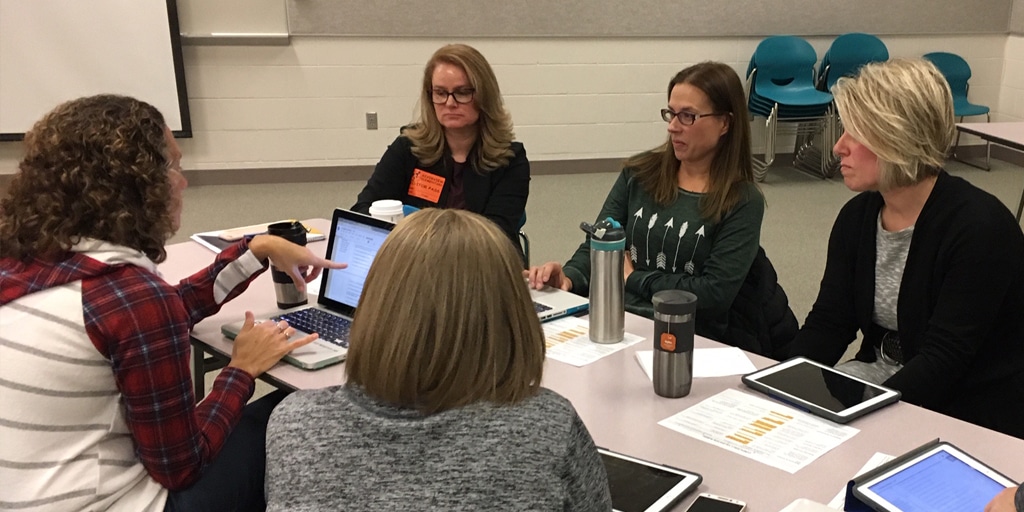For more and more students, including the learners from Farmington Area Public Schools in Farmington, Minnesota, school has a new focus. With personalized, competency-based learning, the focus becomes on what students are learning instead of what teachers are teaching.
This is a shift in mindset. And a shift from requiring teachers to teach and assess all standards to ensuring each student demonstrates their learning of specific high-priority competencies. And everyone – especially students – understands the essential things that every student needs to know and be able to do. While each district approaches how to come to this set of competencies, they provide answers to the same kind of questions:
- What do our students need to understand?
- What do they need to be able to do?
- How will we know that they understand?
- Are there multiple pathways for students to demonstrate learning?
After Farmington researched approaches to identify learning competencies (from people like KnowledgeWorks Director of Teaching and Learning Lori Phillips and Rose Colby, competency-based education pioneer and author of Competency-Based Education: A New Architecture for K-12 Schooling), their teaching and learning team decided that they wanted to start with focused content areas and build from there.
The district solicited teacher volunteers from a variety of content areas to work with their peers in on behalf of their fellow educators and students. With help from Farmington instructional coaches these groups have been working together towards competency-based learning for each content area in the following steps:
- List “I-Can Statements”: When a learner has demonstrated learning, what things would they say they are able to do?
- Identify Power Standards: What are the highest priority standards that students need to learn?
- Develop rubrics to assess learning: How will we know that a student understands?
- Adjust instructional practices: How can we provide multiple pathways for students to learn?

In January, the third, fourth and fifth grade English language arts team got together for a day-long work session led by Kerry Beton, Lisa Edwards and Rick Yonker from Farmington’s teaching and learning team. Teachers wrestled with writing competencies to clearly express what each student should be able to know and be able to do by leveraging some resources from Colby:
The difference between a standard and a competency:
Standard
- Defines the content and skills of a discipline
- Hub for the instructional delivery of content that students then apply to problem-solving or other real-world situations
Competency
- Ability of a student to apply or transfer content and skills in or across content areas.
- Higher-order demand
- Aligned to standards
Source: Competency-Based Education: A New Architecture for K-12 Schooling, Rose Colby, 2017
Teachers worked through a sorting activity with sample standards and competencies to help them understand the difference. For example:
Sample Standards
- Write narratives and other creative texts to develop real or imagined experiences or events using effective technique, descriptive details and clear event sequences
- Distinguish their own point of view from that of the author of a text
- Explain how an author uses reasons and evidence to support particular points in a text
- Determine the meaning of words and phrases as they are used in a text, including those that allude to significant characters found in mythology
- Ask and answer questions to demonstrate understanding of a text, referring explicitly to the text as the basis for the answers
Sample Competencies
- Write effectively for a variety of purposes and audiences
- Listen and view critically and speak purposefully and effectively
- Comprehend, analyze and evaluate increasingly complex texts
- Interpret and apply conventions of the English language to communicate clearly and effectively across the content areas
Source: Adapted from the Rochester School Department, Rochester, NH
Then, teachers started on growth model rubrics based on the academic competencies they identified with the help of the following example framework:
Academic competency: Students will understand how to research and present a topic.
Learning criteria: Characteristics of the learning outcome
- Beginning: Student has basic knowledge and skills in the content areas
- Approaching: Student demonstrates essential content knowledge and skills, however requires guidance to apply knowledge and skills
- Competent: Student demonstrates the ability to apply or transfer content/skills in or across content areas
- Extending: Student extends understanding of essential content and skills using other content areas and/or real-world applications

Near the end of the day, as the teachers reflected on the process of developing these rubrics, one of the third-grade teachers said, “It’s about the process of learning, not the project.”
This ah-ha moment is a great example of the mindset shifts that are happening every day in districts like Farmington as the focus shifts from what teachers teach to what students learn.
Resources to help with developing learning competencies and competency-based rubrics:
- A Handbook for Personalized, Competency-Based Education by Robert J. Marzano, Jennifer S. Norford, Michelle Finn and Douglas Finn III
- A School Leaders Guide to Standards-Based Grading by Tammy Heflebower
- Competency-Based Education: A New Architecture for K-12 Schooling by Rose Colby
- How to Create and Use Rubrics for Formative Assessment and Grading by Susan M. Brookhart







